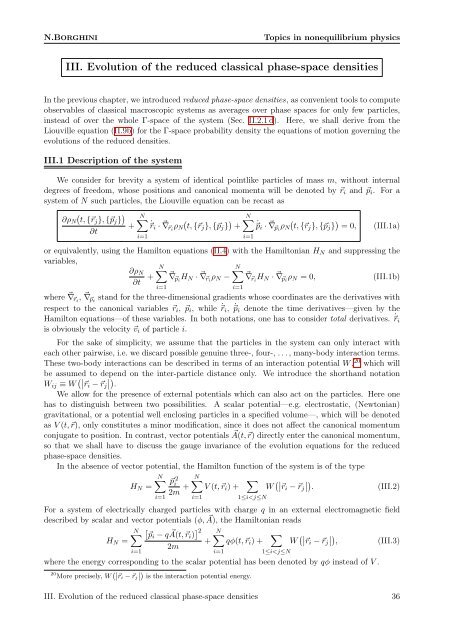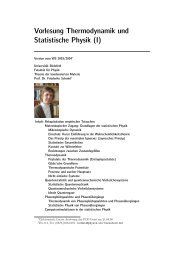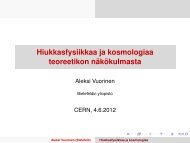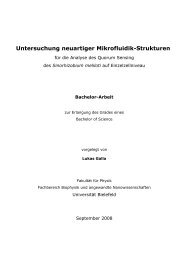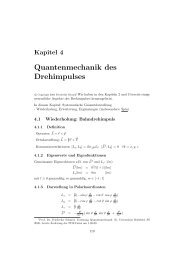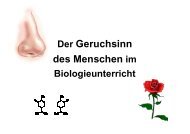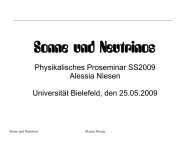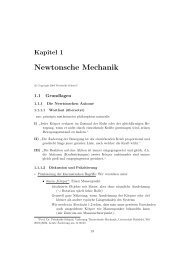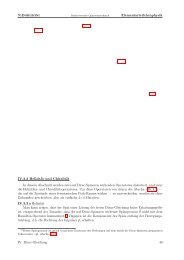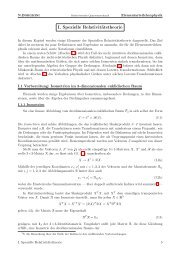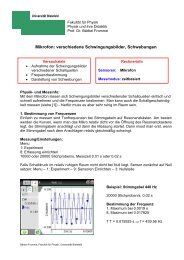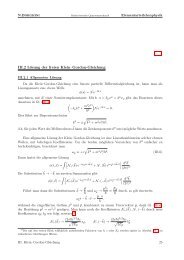Time evolution of reduced phase-space densities. BBGKY hierarchy
Time evolution of reduced phase-space densities. BBGKY hierarchy
Time evolution of reduced phase-space densities. BBGKY hierarchy
You also want an ePaper? Increase the reach of your titles
YUMPU automatically turns print PDFs into web optimized ePapers that Google loves.
N.BORGHINI Topics in nonequilibrium physics<br />
III. Evolution <strong>of</strong> the <strong>reduced</strong> classical <strong>phase</strong>-<strong>space</strong> <strong>densities</strong><br />
In the previous chapter, we introduced <strong>reduced</strong> <strong>phase</strong>-<strong>space</strong> <strong>densities</strong>, as convenient tools to compute<br />
observables <strong>of</strong> classical macroscopic systems as averages over <strong>phase</strong> <strong>space</strong>s for only few particles,<br />
instead <strong>of</strong> over the whole Γ-<strong>space</strong> <strong>of</strong> the system (Sec. II.2.1 d). Here, we shall derive from the<br />
Liouville equation (II.9b) for the Γ-<strong>space</strong> probability density the equations <strong>of</strong> motion governing the<br />
<strong>evolution</strong>s <strong>of</strong> the <strong>reduced</strong> <strong>densities</strong>.<br />
III.1 Description <strong>of</strong> the system<br />
We consider for brevity a system <strong>of</strong> identical pointlike particles <strong>of</strong> mass m, without internal<br />
degrees <strong>of</strong> freedom, whose positions and canonical momenta will be denoted by ri and pi. For a<br />
system <strong>of</strong> N such particles, the Liouville equation can be recast as<br />
<br />
∂ρN t, {rj}, {pj} <br />
+<br />
∂t<br />
N<br />
i=1<br />
˙ri · ∇ri ρN<br />
<br />
t, {rj}, {pj} +<br />
N<br />
i=1<br />
˙pi · ∇pi ρN<br />
<br />
t, {rj}, {pj} = 0, (III.1a)<br />
or equivalently, using the Hamilton equations (II.4) with the Hamiltonian HN and suppressing the<br />
variables,<br />
∂ρN<br />
∂t +<br />
N<br />
∇pi HN · ∇ri ρN<br />
N<br />
− ∇ri HN · ∇pi ρN = 0, (III.1b)<br />
i=1<br />
where ∇ri , ∇pi stand for the three-dimensional gradients whose coordinates are the derivatives with<br />
respect to the canonical variables ri, pi, while ˙ ri, pi<br />
˙ denote the time derivatives—given by the<br />
Hamilton equations—<strong>of</strong> these variables. In both notations, one has to consider total derivatives. ˙ ri<br />
is obviously the velocity vi <strong>of</strong> particle i.<br />
For the sake <strong>of</strong> simplicity, we assume that the particles in the system can only interact with<br />
each other pairwise, i.e. we discard possible genuine three-, four-, . . . , many-body interaction terms.<br />
These two-body interactions can be described in terms <strong>of</strong> an interaction potential W , 20 which will<br />
be assumed to depend on the inter-particle distance only. We introduce the shorthand notation<br />
Wij ≡ W <br />
ri − rj<br />
.<br />
We allow for the presence <strong>of</strong> external potentials which can also act on the particles. Here one<br />
has to distinguish between two possibilities. A scalar potential—e.g. electrostatic, (Newtonian)<br />
gravitational, or a potential well enclosing particles in a specified volume—, which will be denoted<br />
as V (t, r), only constitutes a minor modification, since it does not affect the canonical momentum<br />
conjugate to position. In contrast, vector potentials A(t, r) directly enter the canonical momentum,<br />
so that we shall have to discuss the gauge invariance <strong>of</strong> the <strong>evolution</strong> equations for the <strong>reduced</strong><br />
<strong>phase</strong>-<strong>space</strong> <strong>densities</strong>.<br />
In the absence <strong>of</strong> vector potential, the Hamilton function <strong>of</strong> the system is <strong>of</strong> the type<br />
N N<br />
HN =<br />
V (t, ri) + <br />
W <br />
ri − rj<br />
. (III.2)<br />
i=1<br />
p 2 i<br />
2m +<br />
i=1<br />
i=1<br />
1≤i
N.BORGHINI Topics in nonequilibrium physics<br />
Remark: In the absence <strong>of</strong> interactions, the Hamilton function (III.2) reduces obviously to that <strong>of</strong><br />
an ideal gas.<br />
III.2 <strong>Time</strong> <strong>evolution</strong> <strong>of</strong> <strong>reduced</strong> <strong>phase</strong>-<strong>space</strong> <strong>densities</strong><br />
We now deduce from the Liouville equation (III.1) the equations <strong>of</strong> motion for the <strong>reduced</strong><br />
<strong>phase</strong>-<strong>space</strong> <strong>densities</strong>, first for a system <strong>of</strong> particles in the absence <strong>of</strong> vector potential (Sec. III.2.1),<br />
then for charged particles in a external vector potential (Sec. III.2.2).<br />
Throughout this Section, we shall use the shorthand notations<br />
Fi ≡ − ∇ri V (ri), (III.4a)<br />
Kij ≡ − ∇ri W <br />
ri − rj<br />
, (III.4b)<br />
for the forces upon particle i due to the external potential V and to particle j = i, respectively. In<br />
accordance with Newton’s third law,<br />
Kij = − Kji, (III.4c)<br />
which follows from ∇rj Wij = − ∇ri Wij and the relabeling <strong>of</strong> particles.<br />
III.2.1 System <strong>of</strong> neutral particles<br />
In the absence <strong>of</strong> external vector potential, the Hamilton equations (II.4) with the Hamilton<br />
function (III.2) read<br />
˙ri = ∇pi HN = pi<br />
m , pi<br />
˙ = − ∇ri HN = Fi + <br />
Kij. (III.5)<br />
The first equation simply states that linear momentum and canonical momentum coincide, from<br />
where it follows that the second equation is Newton’s second law.<br />
Accordingly, the Liouville equation (III.1) becomes<br />
∂ρN<br />
∂t +<br />
N<br />
vi · ∇ri ρN +<br />
i=1<br />
N<br />
Fi · ∇pi ρN +<br />
i=1<br />
N<br />
i=1<br />
j=i<br />
N<br />
Kij · ∇pi ρN = 0. (III.6)<br />
III.2.1 a <strong>BBGKY</strong> <strong>hierarchy</strong><br />
✿✿✿✿✿✿✿✿✿✿✿✿✿✿✿✿✿✿✿✿✿✿✿✿✿✿✿<br />
The <strong>reduced</strong> k-particle <strong>phase</strong> density fk(t, r1, p1, . . . , rk, pk) follows from the Γ-<strong>space</strong> probability<br />
density ρN after integrating out the degrees <strong>of</strong> freedom <strong>of</strong> the remaining N − k particles. Similarly,<br />
integrating the Liouville equation (III.6) over the positions and momenta rj, pj <strong>of</strong> N − k particles<br />
gives the <strong>evolution</strong> equation for fk.<br />
This integration relies on a simple fact, namely that the probability density ρN vanishes when<br />
one <strong>of</strong> its <strong>phase</strong>-<strong>space</strong> variables goes to infinity, to ensure the normalization condition (II.1). As a<br />
consequence, integrals <strong>of</strong> the type<br />
<br />
˙ri · ∇ri ρN d 3 <br />
ri or ˙pi · ∇pi ρN d 3 pi<br />
(III.7)<br />
identically vanish. This is here trivial because ˙ ri is independent <strong>of</strong> ri and ˙ pi is independent <strong>of</strong> pi,<br />
so that they can be taken out <strong>of</strong> the respective integrals.<br />
Additionally, we assume that we are allowed to exchange the integration and partial differentiation<br />
operations when needed.<br />
Integrating out N − 1 particles with the proper normalization factor αN,1 = N/(2π) 3 thus<br />
yields for the <strong>evolution</strong> <strong>of</strong> the single-particle <strong>phase</strong>-<strong>space</strong> density (II.18a) the equation<br />
∂f1(t, r1, p1)<br />
∂t<br />
j=1<br />
j=i<br />
+ v1 · ∇r1 f1(t, r1, p1) + F1 · ∇p1 f1(t, r1, p1)<br />
+<br />
N<br />
j=2<br />
N<br />
(2π) 3<br />
<br />
K1j · ∇p1 ρN<br />
<br />
t, {ri}, {pi} d 6(N−1) V = 0.<br />
III. Evolution <strong>of</strong> the <strong>reduced</strong> classical <strong>phase</strong>-<strong>space</strong> <strong>densities</strong> 37
N.BORGHINI Topics in nonequilibrium physics<br />
In the integral in the second line, the N − 2 particles i = j are straightforwardly dealt with.<br />
Thanks to the identity <strong>of</strong> the particles, the remaining integral over d 3 rj d 3 pj/(2π) 3 is independent<br />
<strong>of</strong> the value <strong>of</strong> j, so that the sum <strong>of</strong> j gives N − 1 times the same contribution. Recognizing the<br />
normalization factor N(N −1)/(2π) 6 as that entering the definition <strong>of</strong> the two-particle <strong>phase</strong>-<strong>space</strong><br />
density (II.18a), one can rewrite the equation as<br />
<br />
∂<br />
∂t + v1 · ∇r1 + F1 · <br />
<br />
∇p1 f1(t, r1, p1) = −<br />
K12 · ∇p1 f2(t, r1, p1, r2, p2) d 3 r2 d 3 p2. (III.8a)<br />
The <strong>evolution</strong> equation <strong>of</strong> the single-particle density f1 thus involves the two-particle density f2.<br />
By integrating out N −2 particles in the Liouville equation (III.6), one finds in a similar manner<br />
the equation governing the <strong>reduced</strong> two-particle density21 <br />
∂<br />
∂t + v1 · ∇r1 + v2 · ∇r2 + F1 · ∇p1 + F2 · ∇p2 + K12 · ∇p1<br />
− <br />
∇p2<br />
<br />
f2(t, r1, p1, r2, p2) =<br />
<br />
<br />
− K13 · ∇p1 + K23 · <br />
∇p2 f3(t, r1, p1, r2, p2, r3, p3) d 3 r3 d 3 (III.8b)<br />
p3.<br />
In turn, the <strong>evolution</strong> equation for f2 involves the three-particle <strong>phase</strong>-<strong>space</strong> density f3.<br />
The only trick in deriving this form <strong>of</strong> the <strong>evolution</strong> equation consists in using relation (III.4c)<br />
to rewrite K21 · ∇p2 as − K12 · ∇p2 .<br />
This generalizes to the equation <strong>of</strong> motion for the <strong>reduced</strong> k-particle density fk—obtained by<br />
integrating out N − k particles in the Liouville equation (III.6)—, which is not closed, but depends<br />
on the (k+1)-particle density fk+1 for 1 ≤ k < N:<br />
<br />
∂<br />
∂t +<br />
k<br />
j=1<br />
<br />
vj · ∇rj + Fj · <br />
∇pj +<br />
<br />
k<br />
−<br />
j=1<br />
1≤i
N.BORGHINI Topics in nonequilibrium physics<br />
The most drastic closure prescription, which is discussed in Sec. III.2.1 b below, consists in fully<br />
neglecting interactions. A similar scheme is to keep Eq. (III.8a) intact, yet to assume that the<br />
right-hand side <strong>of</strong> Eq. (III.8b) vanishes. Alternative procedures lead to the Vlasov (Sec. III.2.2 b),<br />
Boltzmann (Chap. IV) or Fokker–Planck (Chap. ??) equations.<br />
III.2.1 b System <strong>of</strong> non-interacting neutral particles: single-particle Liouville equation<br />
✿✿✿✿✿✿✿✿✿✿✿✿✿✿✿✿✿✿✿✿✿✿✿✿✿✿✿✿✿✿✿✿✿✿✿✿✿✿✿✿✿✿✿✿✿✿✿✿✿✿✿✿✿✿✿✿✿✿✿✿✿✿✿✿✿✿✿✿✿✿✿✿✿✿✿✿✿✿✿✿✿✿✿<br />
Consider first the case where the particles in the system are not interacting, i.e. when W vanishes<br />
identically. The Hamilton function HN can then be expressed as the sum <strong>of</strong> the N particles <strong>of</strong> a<br />
single-particle Hamiltonian h ≡ p 2 /2m + V (t, r).<br />
Rewriting the single-particle <strong>phase</strong>-<strong>space</strong> density f1 as f, the <strong>evolution</strong> equation (III.8a) becomes<br />
the single-particle Liouville equation (or collisionless Boltzmann equation)<br />
∂f(t, r, p)<br />
+ v ·<br />
∂t<br />
∇rf(t, r, p) + F · ∇pf(t, r, p) = 0, (III.9)<br />
with F = − ∇rV the external force acting on particles. The contribution v · ∇r + F · <br />
∇p f—which<br />
is actually the Poisson bracket <strong>of</strong> f(t, r, p) and the single-particle Hamiltonian h(r, p)—is <strong>of</strong>ten<br />
referred to as drift term.<br />
This drift term implicitly defines two time scales <strong>of</strong> the system, namely<br />
τs ∼ v · −1, ∇r τe ∼ <br />
F · ∇p<br />
−1.<br />
(III.10)<br />
τs is the time for a particle to cross the typical distance over which the single-particle density f is<br />
varying. As such, it is also the characteristic time scale for smoothing out spatial inhomogeneities<br />
<strong>of</strong> the single-particle distribution.<br />
In turn, τe is the typical time associated with the gradient imposed by the external potential V .<br />
It is thus also the characteristic time scale over which the system inhomogeneities will relax under<br />
the influence <strong>of</strong> F to the equilibrium solution matching the external potential. τe is generally larger<br />
than τs.<br />
III.2.1 c Influence <strong>of</strong> inter-particle interactions<br />
✿✿✿✿✿✿✿✿✿✿✿✿✿✿✿✿✿✿✿✿✿✿✿✿✿✿✿✿✿✿✿✿✿✿✿✿✿✿✿✿✿✿✿✿✿<br />
Let us now consider the effect <strong>of</strong> interactions between particles. Namely, we consider the first<br />
equation (III.8a) <strong>of</strong> the <strong>BBGKY</strong> <strong>hierarchy</strong> with its right-hand side, and we now assume that the<br />
right-hand side <strong>of</strong> the second equation (III.8b) vanishes, i.e. we neglect the influence <strong>of</strong> the threeparticle<br />
density on the <strong>evolution</strong> <strong>of</strong> f2.<br />
Inspecting the resulting <strong>evolution</strong> equations, one finds that there is a new time scale besides τs<br />
and τe, set by the intensity <strong>of</strong> the pairwise interaction, namely<br />
τc ∼ <br />
K · ∇p<br />
−1.<br />
(III.11)<br />
From the <strong>evolution</strong> equation for the two-particle density f2, the collision duration τc appears as the<br />
characteristic time scale over which collisions between two particles smooth out the differences in<br />
their momentum distributions. τc is actually the smallest time scale, much smaller than τs and τe.<br />
As a result, the <strong>evolution</strong> <strong>of</strong> f2 is actually quicker than that <strong>of</strong> f1 in the non-interacting case, for<br />
this quick time scale is absent from the single-particle Liouville equation (III.9). In turn, it means<br />
that when particles are allowed to interact with each other, the pace for <strong>evolution</strong> <strong>of</strong> f1 is not set<br />
by its slow drift term, but by the fast collision term in the right-hand side.<br />
Remark: One could then wonder whether the time scale for the <strong>evolution</strong> <strong>of</strong> f2 is not governed by<br />
the collision term involving f3, which we are neglecting here. It can be checked that this is not the<br />
case in the dilute regime in which only pairwise interactions are important.<br />
In the derivation <strong>of</strong> the <strong>BBGKY</strong> <strong>hierarchy</strong> (III.8), we have from the start assumed that particles<br />
only interact with each other in pairs. It is quite straightforward to see what would happen if we<br />
also allowed for genuine interactions between three, four or more particles.<br />
III. Evolution <strong>of</strong> the <strong>reduced</strong> classical <strong>phase</strong>-<strong>space</strong> <strong>densities</strong> 39
N.BORGHINI Topics in nonequilibrium physics<br />
In that case, there simply come further contributions in the collision and drift terms <strong>of</strong> the <strong>evolution</strong><br />
equations. For instance, when allowing for three-particle interactions, the <strong>evolution</strong> equation<br />
for fk would not only involve fk+1, but also fk+2, corresponding to the case where one particle<br />
among the k under consideration is interacting with two “outsiders”. Despite this complication, one<br />
can still derive an exact <strong>hierarchy</strong> <strong>of</strong> equations.<br />
III.2.1 d <strong>BBGKY</strong> <strong>hierarchy</strong> in position-velocity <strong>space</strong><br />
✿✿✿✿✿✿✿✿✿✿✿✿✿✿✿✿✿✿✿✿✿✿✿✿✿✿✿✿✿✿✿✿✿✿✿✿✿✿✿✿✿✿✿<br />
✿✿✿✿✿✿✿✿✿<br />
Instead <strong>of</strong> characterizing a pointlike particle by a point in its µ-<strong>space</strong>, i.e. by its position and<br />
canonical momentum, one sometimes rather makes use <strong>of</strong> a point in position-velocity <strong>space</strong>, i.e. one<br />
specifies the position and velocity <strong>of</strong> the particles.<br />
In that representation, one can similarly introduce k-particle <strong>densities</strong> over a k-particle positionvelocity<br />
<strong>space</strong>, which will be denoted as fv,k, such that fv,k(t, r1, v1, . . . , rk, vk) d3r1 d3v1 · · · d3rk d3vk is the number <strong>of</strong> particles in the infinitesimal volume element d3r1 d3v1 · · · d3rk d3vk about the point<br />
(r1, v1, . . . , rk, vk). This density fv,k is related to the <strong>reduced</strong> <strong>phase</strong>-<strong>space</strong> density fk by the relation<br />
fv,k(t, r1, v1, . . . , rk, vk) d 3 r1 d 3 v1 · · · d 3 rk d 3 vk = fk(t, r1, p1, . . . , rk, pk) d 3 r1 d 3 p1 · · · d 3 rk d 3 pk.<br />
(III.12)<br />
In the case considered in this Section <strong>of</strong> a system <strong>of</strong> particles in absence <strong>of</strong> an external vector<br />
potential, the velocity v <strong>of</strong> a particle is simply proportional to its canonical momentum p, so that<br />
fv,k is trivially proportional to fk and ∇v to ∇p. One checks at once that the position-velocity <strong>space</strong><br />
<strong>densities</strong> obey a similar <strong>BBGKY</strong> <strong>hierarchy</strong> as the <strong>phase</strong>-<strong>space</strong> <strong>densities</strong>, the only modification being<br />
the substitutions <strong>of</strong> ∇pj by by ∇vj and ˙ pj by ˙ vj. For instance, the first equation <strong>of</strong> the <strong>hierarchy</strong><br />
reads<br />
<br />
∂<br />
∂t + v1 · ∇r1 + F1<br />
m · <br />
<br />
K12<br />
∇v1 fv,1(t, r1, v1) = −<br />
m · ∇v1 fv,2(t, r1, v1, r2, v2) d 3 r2 d 3 v2. (III.13)<br />
The real advantage <strong>of</strong> the formulation in position-velocity <strong>space</strong> is for the case, addressed in the<br />
following Section, <strong>of</strong> a system <strong>of</strong> charged particles in the presence <strong>of</strong> an external vector potential.<br />
III.2.2 System <strong>of</strong> charged particles<br />
We now briefly introduce the subtleties which appear when the particles in the system are<br />
coupled to an external vector potential, as is for instance the case <strong>of</strong> electrically charged particles<br />
in an external (electro)magnetic field.<br />
III.2.2 a Phase-<strong>space</strong> vs. position-velocity <strong>space</strong> description<br />
✿✿✿✿✿✿✿✿✿✿✿✿✿✿✿✿✿✿✿✿✿✿✿✿✿✿✿✿✿✿✿✿✿✿✿✿✿✿✿✿✿✿✿✿✿✿✿✿✿✿✿✿✿✿✿✿✿<br />
The <strong>evolution</strong> equations <strong>of</strong> the <strong>BBGKY</strong> <strong>hierarchy</strong> (III.8) have been derived starting from the<br />
Liouville equation on <strong>phase</strong> <strong>space</strong>, i.e. within the framework <strong>of</strong> a Hamiltonian formalism. A similar<br />
approach can also be adopted in the presence <strong>of</strong> an external vector field, yet there appear two<br />
complications, which can be traced back to the expression <strong>of</strong> the canonical momentum, derived<br />
from the Hamilton equations following from the Hamilton (III.3)<br />
˙ri = ∇pi HN = · · · ˙ pi = − ∇ri HN = · · · (III.14)<br />
• The time derivatives vi = ˙ ri and ˙ pi are no longer independent <strong>of</strong> ri or pi, respectively. As a<br />
consequence, the integrals (III.7) are no longer trivial. Yet by using the Hamilton equations,<br />
one can show at the cost <strong>of</strong> a few integration by parts that their contribution vanishes, so<br />
that the <strong>evolution</strong> <strong>of</strong> the <strong>reduced</strong> <strong>phase</strong>-<strong>space</strong> density fk eventually is governed by an equation<br />
with the same structure as Eq. (III.8c), yet with different factors in front <strong>of</strong> the gradients.<br />
As an example, the collisionless version <strong>of</strong> the <strong>evolution</strong> equation for the single-particle density<br />
f1 ≡ f is<br />
∂f(t, r, p)<br />
+ v ·<br />
∂t<br />
∇rf(t, r, p) + ˙ p · ∇pf(t, r, p) = 0, (III.15)<br />
which differs from Eq. (III.9) because <strong>of</strong> the Hamilton equations (III.14).<br />
III. Evolution <strong>of</strong> the <strong>reduced</strong> classical <strong>phase</strong>-<strong>space</strong> <strong>densities</strong> 40
N.BORGHINI Topics in nonequilibrium physics<br />
• The second issue with the <strong>evolution</strong> equations for the <strong>reduced</strong> <strong>phase</strong>-<strong>space</strong> <strong>densities</strong> derived<br />
within the Hamiltonian formalism is that they are not manifestly gauge invariant, since the<br />
canonical momenta pi are not gauge invariant, see Eq. (III.14).<br />
To remedy the latter problem, it is convenient to consider the <strong>densities</strong> in position-velocity <strong>space</strong>,<br />
instead <strong>of</strong> <strong>phase</strong> <strong>space</strong>. The resulting equations—which then take the same form as in the absence<br />
<strong>of</strong> vector potential—then only involve gauge invariant quantities. For instance, the collisionless<br />
<strong>evolution</strong> equation for the single-particle density fv,1 ≡ fv is<br />
∂fv(t, r, p)<br />
∂t<br />
+ v · ∇rfv(t, r, v) + F<br />
m · ∇vfv(t, r, v) = 0, (III.16)<br />
with F = q( E + v × B) the Lorentz force due to the external electromagnetic fields ( E, B). This<br />
equation is exactly the same as Eq. (III.13) in the absence <strong>of</strong> collision term. One can check that<br />
Eqs. (III.15) under consideration <strong>of</strong> Eq. (III.14) and Eq. (III.16) are actually equivalent.<br />
III.2.2 b Vlasov equation<br />
✿✿✿✿✿✿✿✿✿✿✿✿✿✿✿✿✿✿✿✿✿✿✿✿✿<br />
An important example <strong>of</strong> macroscopic system <strong>of</strong> electrically charged particles is that <strong>of</strong> a<br />
plasma—where one actually has to consider two different types <strong>of</strong> particles, with positive and<br />
negative charges respectively, to ensure the mechanical stability.<br />
In that context, Vlasov has introduced a closure prescription for the corresponding <strong>BBGKY</strong><br />
<strong>hierarchy</strong>, which consists in assuming that the two-particle density factorizes into the product <strong>of</strong><br />
single particle <strong>densities</strong>22 f2(t, r1, v1, r2, v2) f1(t, r1, v1) f1(t, r2, v2). (III.17)<br />
Under this assumption, Eq. (III.13) becomes closed and can be rewritten as<br />
<br />
∂<br />
∂t + v1 · ∇r1 +<br />
<br />
F1<br />
m +<br />
<br />
K12<br />
m f1(t, r2, v2) d 3 r2 d 3 <br />
v2 · <br />
∇v1 f1(t, r1, v1) = 0, (III.18)<br />
with F1 = q Eext<br />
+ v × <br />
Bext the Lorentz force due to the external electromagnetic field. This<br />
constitutes the Vlasov equation.<br />
The integral term inside the brackets can be viewed as an average force exerted by the partner<br />
particle 2 on particle 1. In the specific case <strong>of</strong> an electromagnetic plasma—assuming for simplicity<br />
that the particles in the system have velocities much smaller than the speed <strong>of</strong> light, so that their<br />
mutual interaction is mostly <strong>of</strong> Coulombic nature—this average force is that due to the mean<br />
electrostatic field created by the other particles:<br />
<br />
∂<br />
∂t +v1· q <br />
∇r1 + E ′<br />
+ Eext+v× <br />
m<br />
<br />
<br />
<br />
Bext · ∇v1<br />
f1(t, r1, v1) = 0 with E ′<br />
≡ K12f1(t, r2, v2) d 3 r2 d 3 v2.<br />
The Vlasov assumption is thus an instance <strong>of</strong> mean-field approximation.<br />
Remark: The Vlasov equation (III.18), which in practice has to be solved in a self-consistent<br />
way since the mean field in which f1 evolves depends on f1 itself, is actually nonlinear, and thus<br />
nontrivial.<br />
Bibliography<br />
• Huang [19], chapter 3.5.<br />
• Landau & Lifshitz, vol. 10 [20], chapter I § 16.<br />
• Pottier [10], chapter 4.<br />
22 We do not write this hypothesis as an identity with an = sign to accomodate the possible mismatch between the<br />
normalizations <strong>of</strong> f1 and f2.<br />
III. Evolution <strong>of</strong> the <strong>reduced</strong> classical <strong>phase</strong>-<strong>space</strong> <strong>densities</strong> 41


